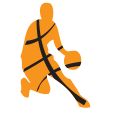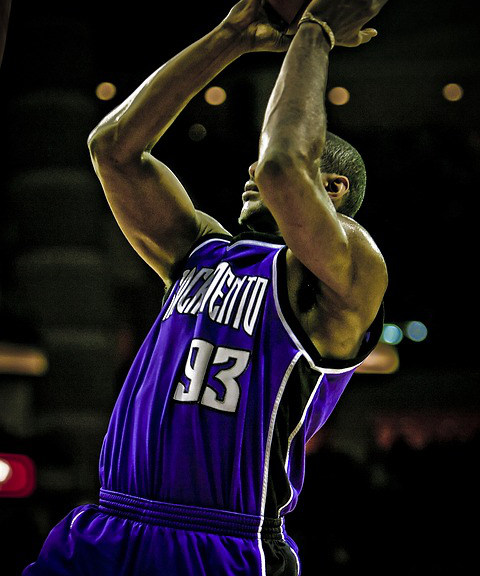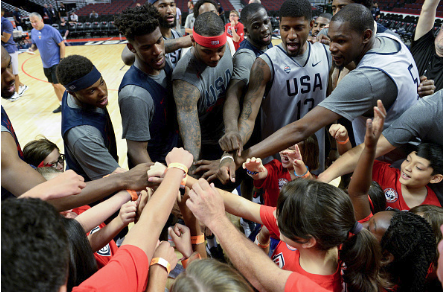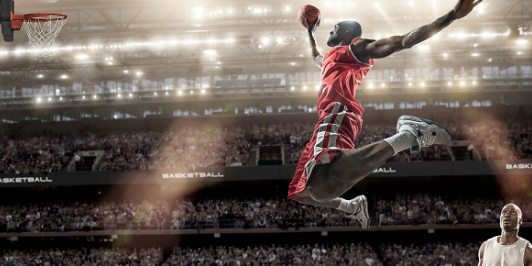As most basketball players and supporters know, having a good vertical leap is extremely beneficial when playing ball. It is useful when shooting, rebounding, and defending, as it gives you an edge over shorter players or ones who are not able to jump as high. Something you may not have known is that your vertical leap is directly related to your power, strength, and muscular endurance. It is very related to sprinting and quick acceleration: the basic principle behind having a good jump is leaving the ground as quickly and explosively as possible.
How Do You Measure Your Current Vertical Jump?
Although most basketballers probably already know how to do this, if you don’t, then follow the simple steps below to measure your vertical leap:
- Holding a piece of tape or chalk in one hand, stand next to a high wall with your feet flat on the ground and mark the highest point that you can reach.
- To measure your jump height, stand next to the wall again and jump as high as you can, marking the wall at the highest point. Repeat this a couple of times, keeping the highest mark you make.
- Measure the difference between your high mark and low mark with a measuring tape to determine your vertical jump height.
Many studies show that your vertical jump is directly related to your athletic ability and the effectiveness of your training program. Measure your jump every two or three weeks so that you can monitor your improvement and make changes to your training if necessary. Note that for a few days after a heavy leg session your vertical jump will naturally be less, which means that you should try and measure it when you are fresh.
How Should You Improve Your Vertical Leap?
As with every skill and aspect of fitness, your vertical jump can be improved through a vigorous, specific training session. The first step is to improve your physical attributes. Boosting your leg strength will go a long way towards boosting your maximal leap. If your leg muscles are weak, then you won’t be able to jump high – no matter how fast you can use them. Improve your leg strength using basic excercises such as squats and deadlifts, while also completing some sprinting and long distance running.
The second physical attribute that you need to work on is acceleration. The higher your acceleration is, the more power you will be able to put into your jump, and the higher your vertical leap will be. The best way to improve your acceleration is through high speed, instant power activities. Complete a range of activities like 20 meter sprints, agility tests, and other fast, high powered things. Once your acceleration improves, then you will be sure to see a difference in your vertical jump.
Although it is not important when testing maximal jump height, muscular endurance can be vital during a game of basketball. Let’s say that you have an amazing vertical leap for your first three jumps, but no muscular endurance. If we translate this to a game of basketball, the you might take the first few rebounds, or block the first few shots that you are defending, but will tire quickly. Once you have tired out, then you will not be able to perform to at the level that you know that you can. You can improve your muscular endurance in a number of ways, namely by performing repetitions of strenuous activities – including things like squats and/or deadlifts.
Improving the Technical Side of Your Vertical Leap:
Having the right physical attributes is only half of achieving your maximum vertical leap. If you have incredible power and acceleration, but are unable to coordinate your muscles to work together, then you won’t be able to jump very high. You must be efficient and technically sound to achieve maximal performance. You can learn the proper jumping technique through a coach, by watching online videos, or ideally, through the self-teaching process below:
- Find a video camera or phone, and have a friend film you completing a vertical leap.
- Compare this to a resource which accurately outlines the techniques and steps needed to perform a quality jump, and note the areas that you need to improve.
- Practice, practice, practice, while continuing to film yourself and identify potential areas of improvement.
The above method works especially well with skilled sportspeople who already have some knowledge of biomechanics and training methods, and who are able to accurately critique themselves.
Drills and Exercises to Improve Your Vertical Leap:
There are a huge range of different exercises and training drills which you can do to improve your vertical jump. According to a number of research papers produced by various institutions, one of the keys to improving your vertical jump is bodyweight plyometrics – explosive exercises which focus on either specific muscle groups of general fitness. Some of the best plyometrics exercise include:
- Squats
- Jumping Rope
- Calf Raises
- Box Jumps
- Hurdles
Final Tips For Maximum Improvement:
If you stick to the exercises and principles outlined earlier, then you will be able to dramatically improve your vertical jump – this is almost guaranteed. However, there are some small things which you can do to further push your improvement and make yourself a better all round sportsperson:
- Get a massage from a physio, and ask them to focus on getting the knots out of your legs – it is incredible how much difference this will make.
- Practice depth jumps – which involve stepping off a box and immediately exploding upwards into a vertical leap – to decrease your reaction time and help your muscles activate in sync.
Read this article well and practice the exercises in it, and you will become one of the best vertical leapers on your team. Don’t trust what I say though, do your own research and verify the facts, and remember, practice, practice, practice.
Maintain hydration during your training sessions while you improve your vertical leap. Reaching new heights requires a great deal of energy and effort. As a result, it is critical to replenish your body’s fluid and electrolyte stores. Consider purchasing a high-quality water bottle to help you keep up your active lifestyle. Its ergonomic design and leak-proof lid allow you to concentrate on your workout without fear of spills or nasty circumstances. Shop today and explore a variety of fantastic water bottle options. For custom orders, don’t hesitate to request a quote.





